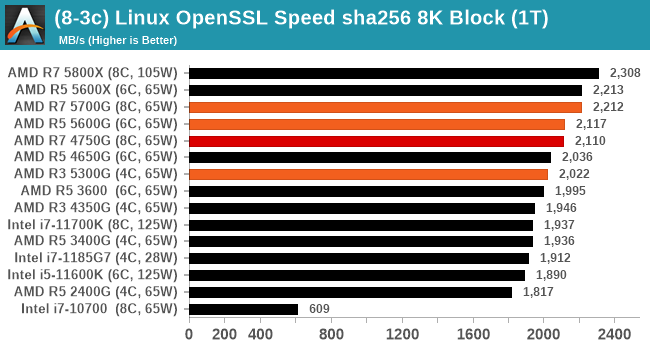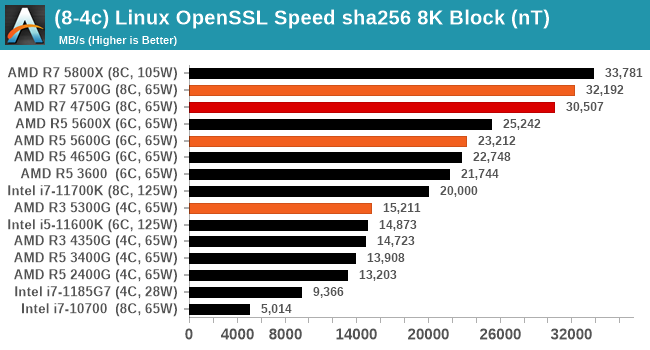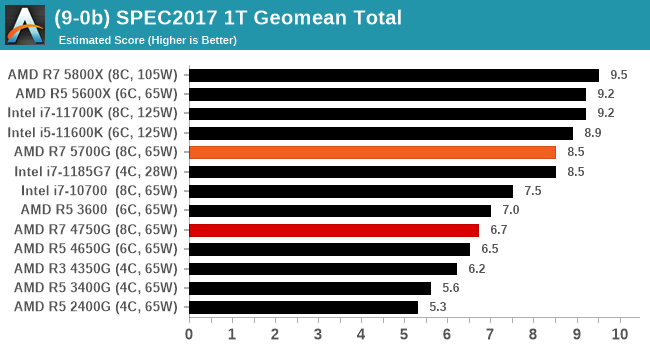The AMD Ryzen 7 5700G, Ryzen 5 5600G, and Ryzen 3 5300G Review
by Dr. Ian Cutress on August 4, 2021 1:45 PM ESTCPU Tests: Synthetic
Most of the people in our industry have a love/hate relationship when it comes to synthetic tests. On the one hand, they’re often good for quick summaries of performance and are easy to use, but most of the time the tests aren’t related to any real software. Synthetic tests are often very good at burrowing down to a specific set of instructions and maximizing the performance out of those. Due to requests from a number of our readers, we have the following synthetic tests.
Linux OpenSSL Speed: SHA256
One of our readers reached out in early 2020 and stated that he was interested in looking at OpenSSL hashing rates in Linux. Luckily OpenSSL in Linux has a function called ‘speed’ that allows the user to determine how fast the system is for any given hashing algorithm, as well as signing and verifying messages.
OpenSSL offers a lot of algorithms to choose from, and based on a quick Twitter poll, we narrowed it down to the following:
- rsa2048 sign and rsa2048 verify
- sha256 at 8K block size
- md5 at 8K block size
For each of these tests, we run them in single thread and multithreaded mode. All the graphs are in our benchmark database, Bench, and we use the sha256 results in published reviews.


GeekBench 5: Link
As a common tool for cross-platform testing between mobile, PC, and Mac, GeekBench is an ultimate exercise in synthetic testing across a range of algorithms looking for peak throughput. Tests include encryption, compression, fast Fourier transform, memory operations, n-body physics, matrix operations, histogram manipulation, and HTML parsing.
I’m including this test due to popular demand, although the results do come across as overly synthetic, and a lot of users often put a lot of weight behind the test due to the fact that it is compiled across different platforms (although with different compilers).
We have both GB5 and GB4 results in our benchmark database. GB5 was introduced to our test suite after already having tested ~25 CPUs, and so the results are a little sporadic by comparison. These spots will be filled in when we retest any of the CPUs.


CPU Tests: SPEC
SPEC2017 and SPEC2006 is a series of standardized tests used to probe the overall performance between different systems, different architectures, different microarchitectures, and setups. The code has to be compiled, and then the results can be submitted to an online database for comparison. It covers a range of integer and floating point workloads, and can be very optimized for each CPU, so it is important to check how the benchmarks are being compiled and run.
We run the tests in a harness built through Windows Subsystem for Linux, developed by our own Andrei Frumusanu. WSL has some odd quirks, with one test not running due to a WSL fixed stack size, but for like-for-like testing is good enough. SPEC2006 is deprecated in favor of 2017, but remains an interesting comparison point in our data. Because our scores aren’t official submissions, as per SPEC guidelines we have to declare them as internal estimates from our part.
For compilers, we use LLVM both for C/C++ and Fortan tests, and for Fortran we’re using the Flang compiler. The rationale of using LLVM over GCC is better cross-platform comparisons to platforms that have only have LLVM support and future articles where we’ll investigate this aspect more. We’re not considering closed-sourced compilers such as MSVC or ICC.
clang version 10.0.0
-Ofast -fomit-frame-pointer
-march=x86-64
-mtune=core-avx2
-mfma -mavx -mavx2
Our compiler flags are straightforward, with basic –Ofast and relevant ISA switches to allow for AVX2 instructions. We decided to build our SPEC binaries on AVX2, which puts a limit on Haswell as how old we can go before the testing will fall over. This also means we don’t have AVX512 binaries, primarily because in order to get the best performance, the AVX-512 intrinsic should be packed by a proper expert, as with our AVX-512 benchmark. All of the major vendors, AMD, Intel, and Arm, all support the way in which we are testing SPEC.
To note, the requirements for the SPEC licence state that any benchmark results from SPEC have to be labelled ‘estimated’ until they are verified on the SPEC website as a meaningful representation of the expected performance. This is most often done by the big companies and OEMs to showcase performance to customers, however is quite over the top for what we do as reviewers.
For each of the SPEC targets we are doing, SPEC2006 1T, SPEC2017 1T, and SPEC2017 nT, rather than publish all the separate test data in our reviews, we are going to condense it down into a few interesting data points. The full per-test values are in our benchmark database.



We’re still running the tests for the Ryzen 5 5600G and Ryzen 3 5300G, but the Ryzen 7 5700G scores strong.










135 Comments
View All Comments
GeoffreyA - Friday, August 6, 2021 - link
Okay, that makes sense.19434949 - Friday, August 6, 2021 - link
Do you know if 5600G or 5700G can output 4k 120fps movie/video playback?GeoffreyA - Saturday, August 7, 2021 - link
Tested this now on a 2200G. Taking the Elysium trailer, I encoded a 10-second clip in H.264, H.265, and AV1 using FFmpeg. The original frame rate was 23.976, so using the -r switch, got it up to 120. Also, scaled the video from 3840x1606 to 3840x2160, and kept the audio (DTS-MA, 8 ch). On MPC-HC, they all ran smoothly. Rough CPU/GPU usage:H.264: 25% | 20%
H.265: 6% | 21%
AV1: 60% | 20%
So if Raven Ridge can hold up at 4K/120, Cezanne should have no problem. Note that the video was downscaled during playback, owing to the screen not being 4K. Not sure if that made it easier. 8K, choppy. And VLC, lower GPU usage but got stuck on the AV1 clip.
GeoffreyA - Sunday, August 8, 2021 - link
Something else I found. 10-bit H.264 seems to be going through software/CPU decoding, whereas 8-bit is running through the hardware, dropping CPU usage down to 6/8%. H.265 hasn't got the same problem. It could be the driver, the hardware, the player, or my computer.mode_13h - Monday, August 9, 2021 - link
> 10-bit H.264 seems to be going through software/CPU decoding...
> It could be the driver, the hardware, the player
It's quite likely the driver or a GPU hardware limitation. There's some nonzero chance it's the player, but I'd bet the player tries to use acceleration and then only falls back on software when that fails.
GeoffreyA - Tuesday, August 10, 2021 - link
Yes, quite likely.mode_13h - Monday, August 9, 2021 - link
> the video was downscaled during playback, owing to the screen not being 4K.> Not sure if that made it easier.
Not usually. I only have detailed knowledge of H.264, where hierarchical encoding is mostly aimed at adapting to different bitrates. That would never be enabled by default, because not only is it more work for the encoder, but it's also poorly supported by decoders and generates slightly less efficient bitstreams.
GeoffreyA - Tuesday, August 10, 2021 - link
"hierarchical encoding"That could be x264's b-pyramid, which, I think, is enabled most of the time. Apparently, allows B-frames to be used as references, saving bits. The stricter setting limits it to the Bluray spec.
GeoffreyA - Tuesday, August 10, 2021 - link
By the way, looking forward to x266 coming out. AV1 is excellent, but VVC appears to be slightly ahead of it.mode_13h - Wednesday, August 11, 2021 - link
> That could be x264's b-pyramidNo, I meant specifically Scalable Video Coding, which is what I thought, but I didn't want to cite the wrong term.
https://en.wikipedia.org/wiki/Advanced_Video_Codin...
The only way the decoder can opt to do less work is by discarding some layers of a SVC-encoded H.264 stream. Under any other circumstance, the decoder can't take any shortcuts without introducing a cascade of errors in all of the frames which reference the one being decoded.
> The stricter setting limits it to the Bluray spec.
I think blu-ray mainly limits which profiles (which are a collection of compression techniques) and levels (i.e. bitrates & resolutions) can be used, so that the bitstream can be decoded by all players and can be streamed off the disc fast enough.
I once tried authoring valid blu-ray video dics, but the consumer-grade tools were too limiting and the free tools were a mess to figure out and use. In the end, I found simply copying MPEG-2.ts files on a BD-R would play it every player I tested. I was mainly interested in using it for a few videos shot on a phone, plus a few things I recorded from broadcast TV.